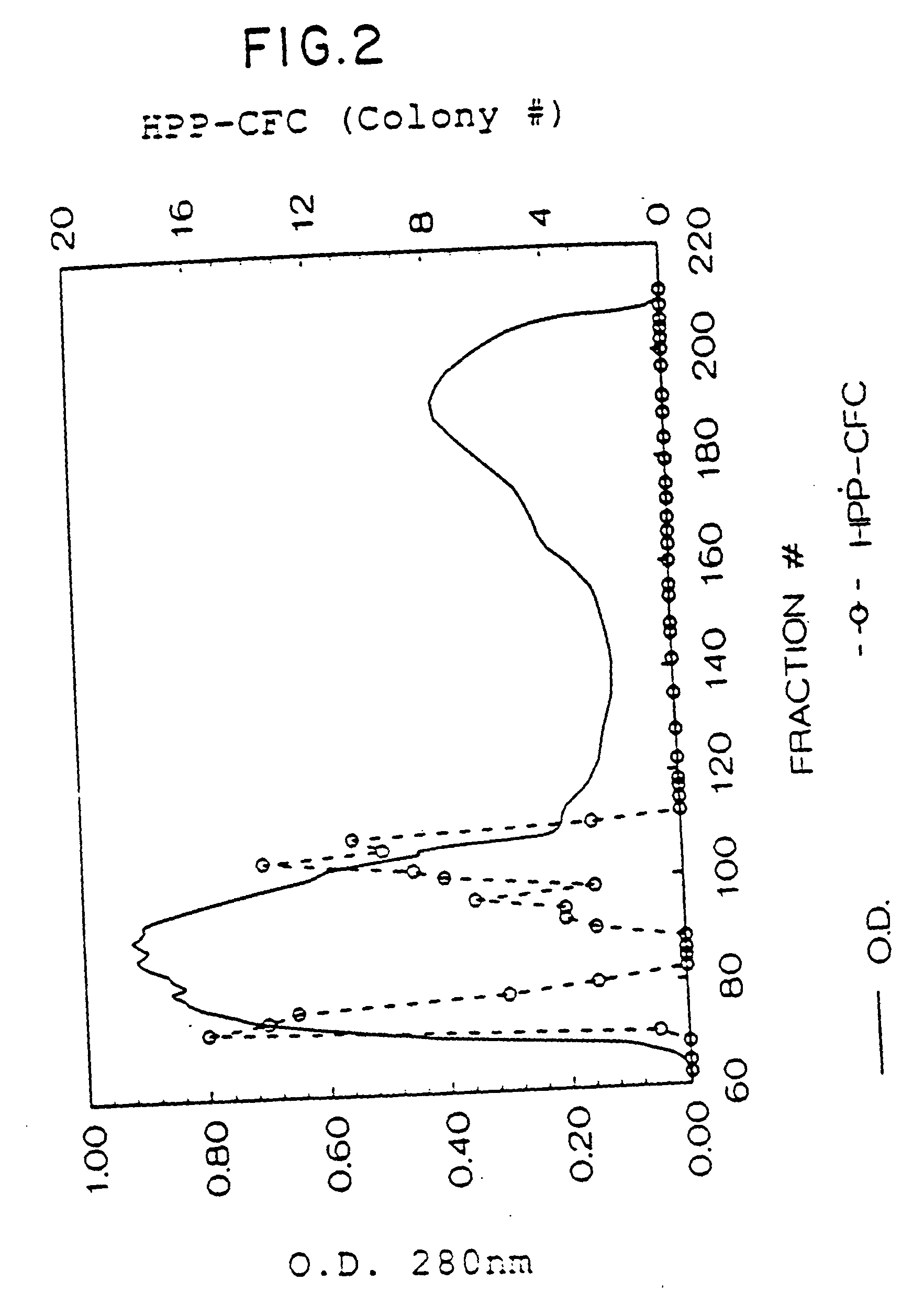SCF antibody compositions and methods of using the same
a technology of scf and composition, which is applied in the field of scf antibody composition, can solve the problems that the combination of il-1 and csf-1 cannot stimulate the same colony formation as can be obtained, and the patient is seriously leukopenic, anemic, or thrombocytopenic, etc., and achieves the effects of prolonging the circulating half-life, prolonging the in vivo half-life, and enhancing the potency of mammals
- Summary
- Abstract
- Description
- Claims
- Application Information
AI Technical Summary
Benefits of technology
Problems solved by technology
Method used
Image
Examples
example 1
Purification / Characterization of Stem Cell Factor from Buffalo Rat Liver Cell Conditoned Medium
A. In Vitro Biological Assays
1. HPP-CFC Assay
[0160] There are a variety of biological activities which can be attributed to the natural mammalian rat SCF as well as the recombinant rat SCF protein. One such activity is its effect on early hematopoietic cells. This activity can be measured in a High Proliferative Potential Colony Forming Cell (HPP-CFC) assay [Zsebo, et al., supra (1988)]. To investigate the effects of factors on early hematopoietic cells, the HPP-CFC assay system utilizes mouse bone marrow derived from animals 2 days after 5-fluorouracil (5-FU) treatment. The chemotherapeutic drug 5-FU selectively depletes late hematopoietic progenitors, allowing for detection of early progenitor cells and hence factors which act on such cells. The rat SCF is plated in the presence of CSF-1 or IL-6 in semi-solid agar cultures. The agar cultures contain McCoys complete medium (GIBCO), 2...
example 2
Amino Acid Sequence Analysis of Mammalian SCF
A. Reverse-phase High Performance Liquid Chromatography (HPLC) of Purified Protein
[0185] Approximately 5 μg of SCF purified as in Example 1 (concentration=0.117 mg / ml) was subjected to reverse-phase HPLC using a C4 narrowbore column (Vydac, 300 Å widebore, 2 mm×15 cm). The protein was eluted with a linear gradient from 97% mobile phase A (0.1% trifluoroacetic acid) / 3% mobile phase B (90% acetonitrile in 0.1% trifluoroacetic acid) to 30% mobile phase A / 70% mobile phase B in 70 min followed by isocratic elution for another 10 min at a flow rate of 0.2 ml per min. After subtraction of a buffer blank chromatogram, the SCF was apparent as a single symmetrical peak at a retention time of 70.05 min as shown in FIG. 10. No major contaminating protein peaks could be detected under these conditions.
B. Sequencing of Electrophoretically-Transferred Protein Bands
[0186] SCF purified as in Example 1 (0.5-1.0 nmol) was treated as follows with N-gly...
example 3
Cloning of the Genes for Rat and Human SCF
A. Amplification and Sequencing of Rat SCF cDNA Fragments
[0201] Determination of the amino acid sequence of fragments of the rat SCF protein made it possible to design mixed sequence oligonucleotides specific for rat SCF. The oligonucleotides were used as hybridization probes to screen rat cDNA and genomic libraries and as primers in attempts to amplify portions of the cDNA using polymerase chain reaction (PCR) strategies ([Mullis et al., Methods in Enzymol. 155, 335-350 (1987)]. The oligodeoxynucleotides were synthesized by the phosphoramidite method [Beaucage, et al., Tetrahedron Lett., 22, 1859-1862 (1981); McBride, et al., Tetrahedron Lett., 24, 245-248 (1983)]; their sequences are depicted in FIG. 12A. The letters represent A, adenine; T, thymine, C, cytosine; G, guanine; I, inosine. The * in FIG. 12A represents oligonucleotides which contain restriction endonuclease recognition sequences. The sequences are written 5′-3′.
[0202] A ra...
PUM
| Property | Measurement | Unit |
|---|---|---|
| concentrations | aaaaa | aaaaa |
| concentrations | aaaaa | aaaaa |
| concentrations | aaaaa | aaaaa |
Abstract
Description
Claims
Application Information
 Login to View More
Login to View More - R&D
- Intellectual Property
- Life Sciences
- Materials
- Tech Scout
- Unparalleled Data Quality
- Higher Quality Content
- 60% Fewer Hallucinations
Browse by: Latest US Patents, China's latest patents, Technical Efficacy Thesaurus, Application Domain, Technology Topic, Popular Technical Reports.
© 2025 PatSnap. All rights reserved.Legal|Privacy policy|Modern Slavery Act Transparency Statement|Sitemap|About US| Contact US: help@patsnap.com



